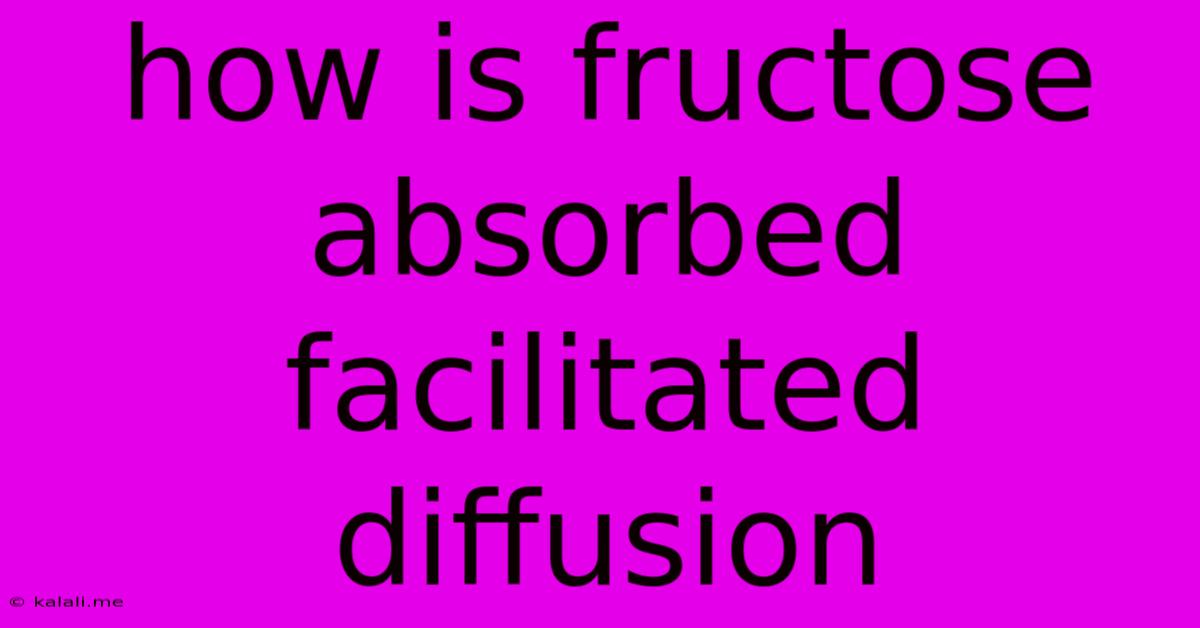How Is Fructose Absorbed Facilitated Diffusion
Kalali
May 09, 2025 · 3 min read

Table of Contents
How is Fructose Absorbed via Facilitated Diffusion? A Deep Dive into Intestinal Transport
Fructose, a monosaccharide found naturally in fruits and honey and added to many processed foods, is absorbed differently than glucose and galactose in the small intestine. Unlike these other sugars, which utilize sodium-dependent glucose transporters (SGLTs), fructose absorption relies primarily on facilitated diffusion via GLUT5 transporters. This process, while seemingly simpler, involves several intricate steps and is influenced by various factors. This article explores the mechanism of fructose absorption, highlighting its unique characteristics and underlying complexities.
The Role of GLUT5 Transporters
The primary player in fructose absorption is the glucose transporter type 5, or GLUT5. These transporters are located on the apical membrane of enterocytes – the cells lining the small intestine. GLUT5 is a specific fructose transporter, meaning it displays high affinity for fructose and exhibits minimal transport activity for other hexoses. This specificity is crucial for efficient fructose uptake from the intestinal lumen.
The process itself is passive, meaning it doesn't require energy expenditure in the form of ATP. Instead, fructose moves down its concentration gradient, from an area of high concentration (the intestinal lumen after digestion) to an area of lower concentration (inside the enterocyte). This movement is facilitated by GLUT5, which acts as a carrier protein, speeding up the transport across the cell membrane significantly. Without GLUT5, fructose absorption would be considerably slower.
From Lumen to Bloodstream: The Transcellular Pathway
The journey of fructose from the intestinal lumen to the bloodstream is a transcellular process, meaning it occurs across the enterocyte. Here's a breakdown:
-
Apical Uptake: Fructose enters the enterocyte through the apical membrane via GLUT5. The rate of this uptake is directly proportional to the luminal fructose concentration, up to the transporter's saturation point. Beyond this point, increasing luminal fructose won't significantly enhance absorption.
-
Intracellular Diffusion: Once inside the enterocyte, fructose moves through the cytoplasm via simple diffusion. This passive movement is driven by the concentration gradient established by the initial uptake at the apical membrane and subsequent efflux at the basolateral membrane.
-
Basolateral Efflux: Fructose exits the enterocyte through the basolateral membrane, primarily via GLUT2 transporters. GLUT2 is a bidirectional transporter, meaning it can facilitate fructose movement in either direction depending on the concentration gradient. In this case, it moves fructose from the high concentration within the enterocyte into the lower concentration in the portal vein. From here, fructose enters the systemic circulation.
Factors Influencing Fructose Absorption
Several factors can influence the rate and efficiency of fructose absorption:
-
Fructose Concentration: As previously mentioned, absorption rate increases with luminal fructose concentration, until transporter saturation. Consuming extremely high fructose levels may lead to incomplete absorption and potential gastrointestinal distress.
-
GLUT5 Expression: The number of GLUT5 transporters on the apical membrane influences the maximal absorption rate. Genetic variations or certain conditions can affect GLUT5 expression.
-
Presence of other sugars: While fructose absorption is largely independent of glucose and galactose, the presence of high concentrations of other sugars might influence the overall rate of absorption through competition for available transporters or changes in intestinal transit time.
-
Gut Microbiota: The composition of the gut microbiota may also play a role in the metabolism of absorbed fructose. Further research is needed to fully understand this aspect.
Conclusion
Fructose absorption via facilitated diffusion, mediated primarily by GLUT5 transporters, is a fascinating example of passive transmembrane transport. Understanding this process is crucial for comprehending fructose metabolism and its potential impact on health. While generally efficient, the process is influenced by multiple factors, highlighting the complex interplay between diet, genetics, and intestinal physiology. Further research into the nuanced aspects of fructose absorption is ongoing and promises to enhance our understanding of its role in overall health and disease.
Latest Posts
Latest Posts
-
How To Increase Current In A Circuit
May 09, 2025
-
What Does 2 1 4 Cups Equal
May 09, 2025
-
How Long Is 77 Inches In Feet
May 09, 2025
-
What Is The Fraction Of 125
May 09, 2025
-
How Many Feet Is 34 In
May 09, 2025
Related Post
Thank you for visiting our website which covers about How Is Fructose Absorbed Facilitated Diffusion . We hope the information provided has been useful to you. Feel free to contact us if you have any questions or need further assistance. See you next time and don't miss to bookmark.